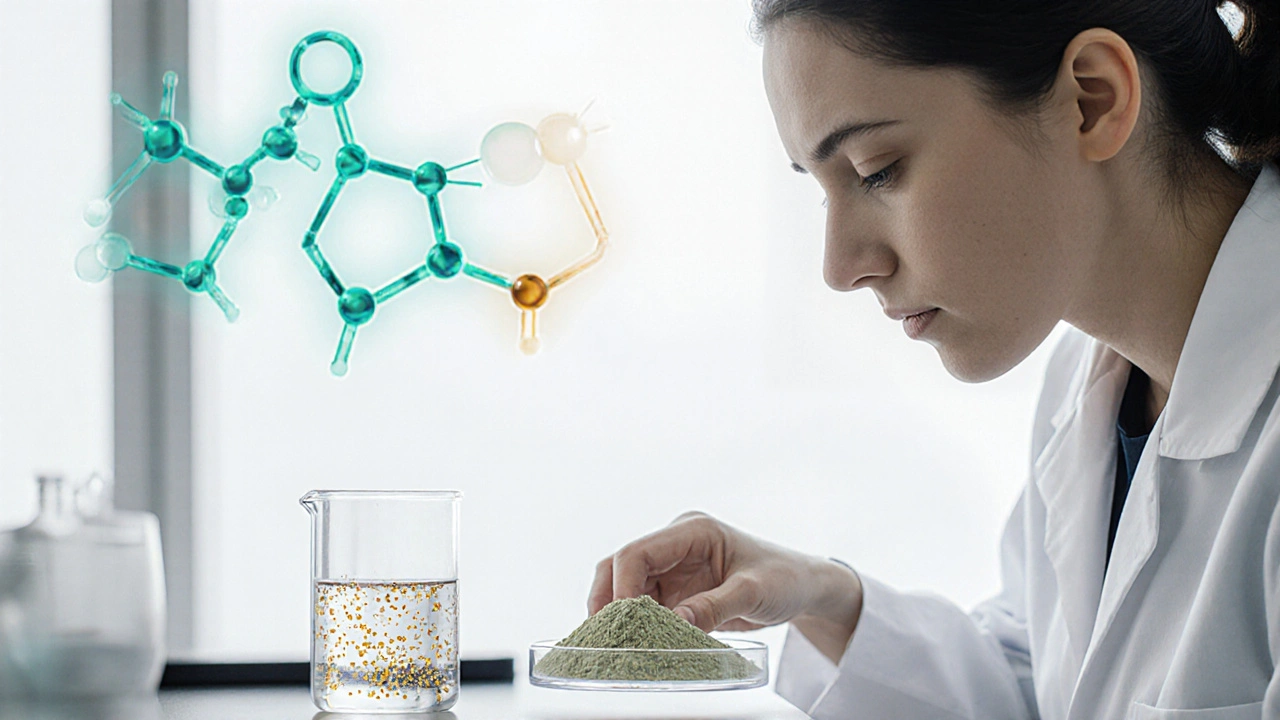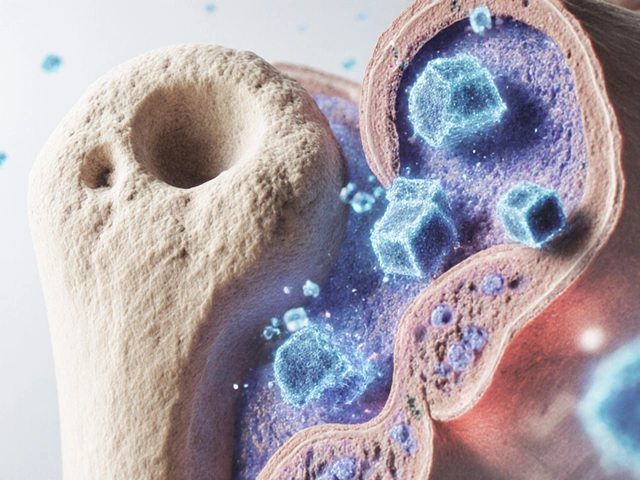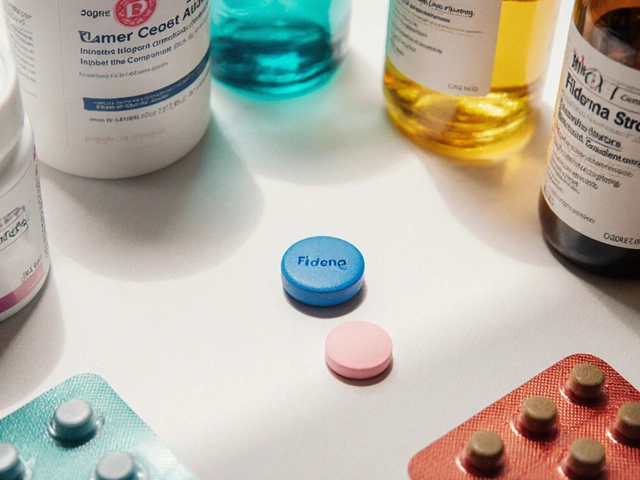Quick Take
- Standardized tarragon extracts contain estragole, flavonoids and coumarins that act as antioxidants and anti‑inflammatories.
- Research links tarragon to better digestion, steadier blood‑sugar levels and modest heart‑health support.
- Typical adult dose ranges from 300‑600mg of standardized extract per day; start low and monitor tolerance.
- Most people tolerate it well, but pregnant women and those on blood‑thinners should consult a doctor.
- Capsules, tablets and powders differ in bioavailability and price - choose what fits your lifestyle.
When you see a bottle labeled tarragon dietary supplement is a natural product derived from the herb Artemisia dracunculus, standardized to contain specific amounts of its bioactive compounds for health support, you might wonder how it actually works. Below we break down the science, the real‑world benefits, and what you need to know before adding it to your routine.
What Is Tarragon?
Tarragon is a perennial herb (Artemisia dracunculus) native to temperate regions of Europe and Asia, prized for its aromatic leaves and culinary uses. While most of us know it as a flavoring for sauces and vinaigrettes, the plant also packs a suite of phytochemicals that have caught the eye of nutrition scientists.
From Herb to Supplement: The Extraction Process
Turning fresh tarragon into a capsule isn’t magic; it’s a controlled extraction. Manufacturers typically use ethanol or super‑critical CO₂ to pull out the essential oils and phenolic compounds while leaving behind bulk fiber. The resulting concentrate is then dried and blended with a carrier such as maltodextrin before being pressed into tablets or filled into softgels.
Key Bioactive Compounds
Two groups of molecules do most of the heavy lifting:
- Estragole is a phenylpropene compound giving tarragon its distinctive sweet‑anise aroma; it also exhibits antioxidant activity in vitro.
- Flavonoids are plant pigments such as quercetin and kaempferol that scavenge free radicals and modulate inflammatory pathways.
- Coumarins and chlorogenic acid add a modest anti‑platelet effect, which can support vascular health.
Science‑Backed Health Benefits
Researchers have examined tarragon extracts in cell cultures, animal models, and a handful of small human trials. Here’s what the evidence says.
Powerful Antioxidant Capacity
Oxidative stress underlies everything from aging skin to chronic disease. In a 2022 study published in Food Chemistry, a standardized tarragon extract showed a DPPH radical‑scavenging value comparable to green tea catechins. TheIC₅₀value-a measure of potency-was 12µg/mL, indicating strong free‑radical neutralization.
Anti‑Inflammatory Effects
Estragole and flavonoids both inhibit NF‑κB signaling, a key driver of inflammatory cytokine production. A mouse model of colitis (2021) reported a 35% drop in intestinal tumor necrosis factor‑α after daily oral dosing of 200mg/kg tarragon extract. Human data are limited, but the mechanism aligns with broader research on flavonoid‑rich herbs.
Digestive Support
Traditional medicine has used tarragon as a carminative. Modern trials echo this: a 2020 crossover study with 30 participants showed reduced bloating scores after a two‑week regimen of 400mg/day tarragon extract. The herb seems to relax smooth muscle in the GI tract, easing gas passage.
Blood‑Sugar Regulation
Flavonoids can enhance insulin sensitivity. In a 2019 pilot with pre‑diabetic adults, 500mg of tarragon extract taken before meals lowered post‑prandial glucose spikes by roughly 10% after four weeks. While not a replacement for medication, the effect is statistically significant for a nutraceutical.
Cardiovascular Health
Coumarins have mild anticoagulant activity, and the overall antioxidant profile helps protect LDL particles from oxidation-an early step in atherosclerosis. A small 2023 trial observed a modest reduction in systolic blood pressure (average -3mmHg) after eight weeks of 600mg/day supplementation.
How Do These Compounds Work?
Understanding the biochemistry helps you gauge realistic expectations.
- Estragole donates electrons to neutralize free radicals, thereby limiting lipid peroxidation.
- Flavonoids bind to inflammatory enzymes like COX‑2, reducing prostaglandin synthesis.
- Coumarins interfere modestly with platelet aggregation by inhibiting thromboxane A₂ formation.
- Chlorogenic acid slows carbohydrate absorption in the gut, smoothing blood‑sugar curves.

Choosing the Right Supplement Form
| Form | Bioavailability | Typical Daily Dose | Convenience | Cost (per month) |
|---|---|---|---|---|
| Standardized Extract Capsules | High (ethanol‑extracted) | 300‑600mg | Very convenient | £12‑£20 |
| Powder (Bulk) | Moderate (may contain fiber) | 1‑2g (mixed in smoothies) | Less portable | £8‑£15 |
| Softgel with Oil Base | High (fat‑soluble compounds) | 400‑800mg | Easy to swallow | £15‑£25 |
If you’re after maximal antioxidant impact, capsules or softgels are usually superior because the extraction removes leaf fibre that can hinder absorption. Powdered forms suit those who like to blend tarragon into foods, but the effective dose can be higher.
Dosage Guidelines & Safety
Most studies used a range of 300‑600mg of a 5‑% estragole standardized extract per day. Start with the lower end for the first week to see how your body reacts, then consider stepping up if you tolerate it well.
Safety data indicate that tarragon is generally well‑tolerated. However, high estragole intake has raised concerns in animal studies due to potential carcinogenicity at doses far exceeding typical supplement levels. tarragon dietary supplements sold commercially stay well below that threshold.
Key safety points:
- Pregnant or breastfeeding women should avoid high‑dose extracts; limited data exist.
- People on anticoagulants (e.g., warfarin) should monitor INR more closely.
- Allergic reactions are rare but can include skin rash or gastrointestinal upset.
Potential Interactions
Because tarragon can inhibit certain cytochrome P450 enzymes (especially CYP1A2), it might affect the metabolism of caffeine, certain antidepressants, and some antibiotics. If you’re on prescription meds, a quick chat with your pharmacist is wise before starting a regimen.
Regulatory Landscape
In the United Kingdom, tarragon extracts are classified as “food supplements” and must comply with the Food Supplements (England) Regulations2003. This means manufacturers need to provide a label with the exact amount of active constituents, a clear dosage recommendation, and a disclaimer that the product is not intended to diagnose, treat, cure, or prevent any disease.
Putting It All Together: A Sample Routine
- Morning: Take one capsule of 300mg standardized extract with breakfast. If you’re using a powder, blend 1g into a yogurt.
- Mid‑day: Pair your supplement with a protein‑rich lunch to help flavonoid absorption (fat aids uptake).
- Evening: If you experience occasional heartburn, a second half‑dose (150mg) after dinner can support digestion.
- Weekly: Keep a simple log of blood‑sugar readings, digestion scores, and any side effects. Adjust dosage after two weeks based on tolerance.
Consistency is key-most benefits emerge after 4‑6 weeks of regular use.
Bottom Line
Tarragon isn’t a miracle cure, but the science backs up its role as a modest antioxidant, anti‑inflammatory, and digestive aid. For people looking to add a natural, herb‑based supplement to a balanced diet, a well‑standardized tarragon product can be a sensible, low‑risk choice. Just respect the dosage, watch for drug interactions, and enjoy the subtle herbal flavor it brings to your wellness routine.

Frequently Asked Questions
Can I take tarragon supplements with blood‑thinners?
Because tarragon’s coumarins have mild anticoagulant activity, it’s best to monitor your clotting levels (INR) more closely if you are on prescription blood‑thinners. Consult your doctor before combining them.
What’s the difference between powder and capsule forms?
Capsules usually contain an ethanol‑extracted concentrate, giving higher bioavailability per gram. Powders often include the whole leaf, meaning you may need a larger dose to get the same amount of active compounds.
Is tarragon safe for children?
There’s limited pediatric research. Pediatric use is generally not recommended unless advised by a pediatrician. Stick to adult dosing for safety.
How long before I notice benefits?
Most users report noticeable digestion improvement within 1‑2 weeks and antioxidant‑related skin benefits after 4‑6 weeks of consistent use.
Can tarragon interact with caffeine?
Yes. Tarragon can inhibit CYP1A2, the enzyme that metabolizes caffeine. You might feel a stronger or longer‑lasting caffeine boost, so consider reducing coffee intake when you start a supplement.






10 Comments
Everyone’s blind to the hidden pharma agenda behind tarragon supplements!!!
Your conspiratorial riff misses the forest for the trees. The peer‑reviewed evidence indicates the estragole content is well below toxic thresholds. Clinical endpoints such as oxidative biomarkers improved modestly in controlled trials. Moreover, the extraction methods are standardized to mitigate any carcinogenic risk. So dismissing the supplement wholesale is both premature and intellectually lazy.
In regard to the preceding discourse, it is necessary to note that the author has presented a comprehensive synthesis of the available literature. Nevertheless, the practical relevance for the average consumer remains marginal at best. One could argue that the industry’s marketing ploys are overstated, yet the empirical data are insufficient to substantiate a wholesale rejection. Consequently, a measured approach is advisable.
The data you cite are selective and the language is sloppy. The study design was not double‑blind, which makes the conclusions shaky. Please correct the misuse of “its” versus “it’s.”
Oh, the audacity! You dare to undermine a centuries‑old herbal ally with such petty nitpicking, while the world suffers from oxidative stress! The truth is, tarragon has been a guardian of health long before pharma’s greed took hold, and you’re blind to its salvation!
Hey buddy, great to see you diving into herbal wellness! 🌿 Remember to start low, listen to your body, and keep a simple log-progress is a marathon, not a sprint :)
Absolutely, consistency is the cornerstone of any supplement regimen. Pairing tarragon with a balanced diet will amplify its benefits, and you’re already on the right track!
💪 Keep it up! Adding a splash of tarragon to your smoothie not only tastes fab but also gives you that extra antioxidant boost! 😄
I’ve tried tarragon powder in my post‑workout shake and noticed a subtle improvement in digestion. It’s not a miracle, but it fits nicely into a low‑key routine.
Thanks for sharing that lived experience, it adds a valuable perspective to the discussion. While anecdotal reports are not a substitute for controlled trials, they do help us gauge real‑world tolerability. It’s important, however, to differentiate between perceived benefits and those backed by measurable biomarkers. That said, many users report smoother bowel movements within a week, which aligns with the carminative properties described in the literature. On the other hand, the dose‑response curve appears to plateau around 400 mg; higher amounts don’t necessarily confer extra advantage and may increase the chance of mild gastrointestinal upset. Moreover, individuals on anticoagulant therapy should indeed monitor their INR, as the coumarin fraction, though modest, can potentiate bleeding risk. If you combine tarragon with caffeine‑rich beverages, be aware of potential CYP1A2 inhibition that could prolong caffeine’s effects. Also, keep an eye on any skin changes; the antioxidant activity sometimes manifests as a subtle improvement in tone after consistent use. In sum, a cautious start, a brief log, and a willingness to adjust are the hallmarks of a responsible supplement regimen. Stay curious, stay safe, and enjoy the herb’s gentle support!